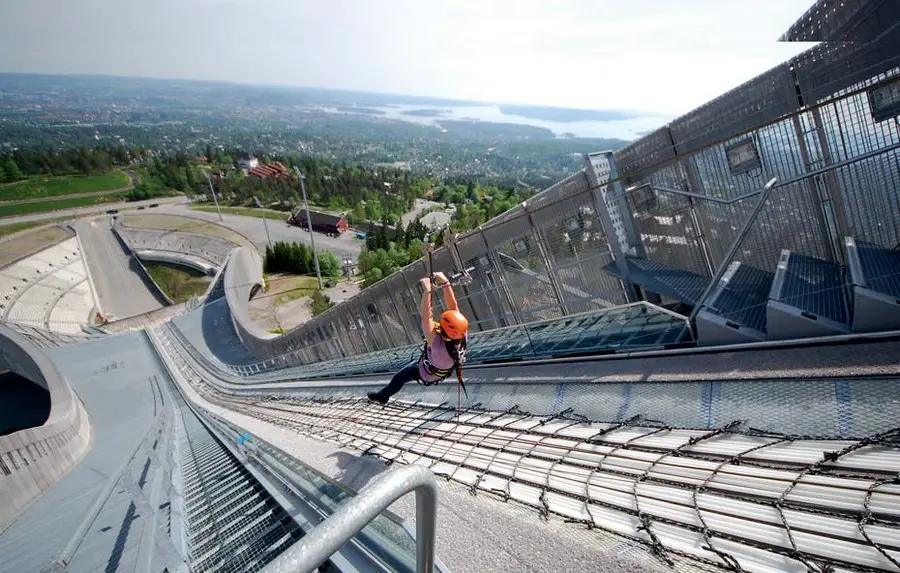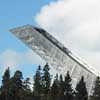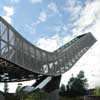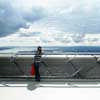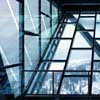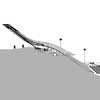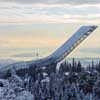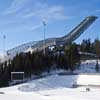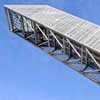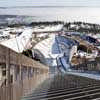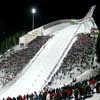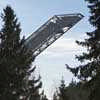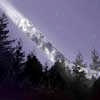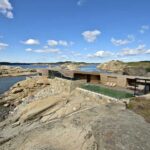Holmenkollen Ski Jump Norway, Norwegian Winter Sports Architecture Image, Architect Design News
Holmenkollen Ski Jump, Oslo Architecture
Contemporary Norwegian Building: Tower + Arena design by JDS Architects
6 May 2011
Norwegian Steel Construction Prize
It was announced today at the seminar “Materials and Resistance” in Oslo that the Holmenkollen Ski Jump designed by JDS Architects was the recipient for the Norwegian Steel Construction Prize 2011. Norwegian Steel Construction Prize was first awarded in 1991 to Stranden, Aker Brygge.
Holmenkollen Ski Jump Award
Yourway has installed a zip line to our Skijump so you can also experience the thrilling madness of going down Holmenkollen, in complete safety – image added 22 May 2013:
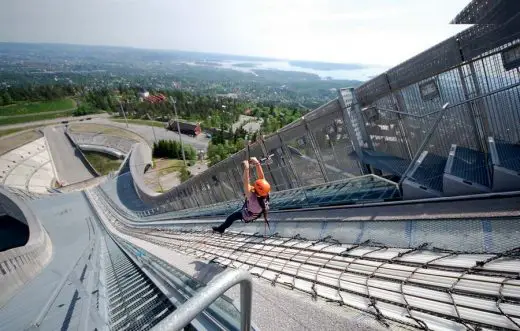
photo from architects
The Norwegian Steel Association and the Norwegian Association of Steel Structures are responsible for the prize competition which is held every other year. Winners are held at a very high standard and therefore reflect the necessary prestige that is important for the value of steel and the environment. The prize is awarded to the builders, architects, consulting engineering and steel construction.
A presentation of the winning project and award ceremony will take place under the Norwegian Ståldag (Steel Day), the 3rd of November 2011 at the Grand Hotel in Oslo.
23 Feb 2011
Holmenkollen Ski Jump Oslo
Designed By JDS Architects, The New Holmenkollen Skijump Will Host The 2011 FIS Nordic World Ski Championships
23 February – 6 March 2011
More than 100 years ago, a Norwegian lieutenant propelled himself 9.5 meters into the air and the sport of ski jumping was born. Since 1892, the village of Holmenkollen, twenty minutes from Oslo, has hosted legendary competitions and the site remains one of the foremost locales for the international sport including the 1952 Winter Olympics.
New photos added 24 Feb of Holmenkollen Ski Jump:
Along with Wimbledon’s All England Club and the Wembley Arena, Holmenkollen Ski Jump is often cited as one of the world’s most recognizable sports facility. Nevertheless it is one of the smallest hills in the World Cup tournament, and in September 2005, the International Ski Federation decided that the current hill does not meet the standards to award the city the 2011 FIS Nordic World Ski Championships.
In December 2005 Norway’s Directorate of Cultural Heritage approved the demolition of the ski jump and in April 2007 the Oslo municipality announced an open international competition for a new ski jump. JDS Architects based in Copenhagen and led by Belgian-French Julien De Smedt, beat out 103 other firms and was awarded the commission the following year.
Working closely with city officials, JDSA established an office in the capital and collaborated with Norwegian engineering firm, Norconsult, to bring to fruition their elegant serpentine form that will become a beacon for the city and a new showcase for the sport of ski jumping. Rather than having a series of dispersed pavilions on site, their design unifies the various amenities into one holistic diagram.
The judges booths, the commentators, the trainers, the royal family, the VIPs, the wind screens, the circulations, the lobby, the entrance to the arena and the arena itself, the lounge for the skiers, the souvenir shop, the access to the existing museum, the viewing public square at the very top, everything, is contained into the shape of the jump.
The resulting simplicity of the solution improves the experience of the spectators and brings clear focus to the skiers. The ski jump is clad in aluminum and glass and rises 58 meters in the air. It cantilevers an impressive 69 meters and on the first day of jumping tests; the record of the longest jump made at Holmenkollen was broken.
Atop the ski jump is a platform where visitors can take in some of the most breathtaking views of Oslo, the fjord and the region beyond. It’s a new form of public space, using an unlikely architectural form as its host, affording the same spectacular vantage point for everyone who comes to Holmenkollen.
The Lonely Planet agrees, the travel publication recently declared the new Holmenkollen Ski Jump as one of the ten top destinations to visit in 2011.
Holmenkollen Ski Jump Test
On the 13th and 14th of March, the International Ski Federation (FIS) World Cup Nordic will be held at Holmenkollen with over 30,000 people are expected to attend. The jump is to be held as a trial test before the FIS Nordic World Ski Championships next year in Oslo, 24th of February – 6th March 2011.
On the 3rd of February, the International Ski Federation (FIS) certified the New Holmenkollen Fyr (HS134) that the facility passed all technical and safety standards required for international ski jumping competitions.
Holmenkollen Ski Jump images : JDS / JULIEN DE SMEDT ARCHITECTS
JDS Architects contracted to build the new Holmenkollen Ski Jump in Oslo, Norway
In September 2007 JDS Architects won the international competition for a new Holmenkollen ski jump in Oslo and have now been commissioned to build the new jump tower and arena for the World Championship in 2011.
Located on the hillside north west of Oslo centre, Holmenkollen stands out as an iconic landmark for the city of Oslo as well as for the entire nation.
The new ski jump will replace the existing ski jump and will be built at the same site where it has resided since the first Holmenkollen ski jump was erected in 1892. Since then the jump has been rebuilt 18 times.
The new ski jump will be completed in time for the 2011 World Championship and bring the Holmenkollen ski jump up to date with new standards and regulations in accordance with the international skiing federation. The silhouette of the new tower has a sharp and simple cut.
The profile follows the jumpers descent and is offset to create necessary wind protection. The smooth and bended rectangle hosts the slope, the main structure and circulation with an inclined elevator running from the bottom to the top where a 50 m2 bar/jumpers lounge and jump platform is located. The top is cut horizontally to accommodate a viewing platform with a 360º panorama view over the Oslo city landscape.
JDS Architects have just opened a new office in Oslo – permanent contact details and information will be announced soon.
Holmenkollen Ski Jump Norway – images / information from JDS Architects 080508
Holmenkollen Ski Jump design : JDS / Julien De Smedt Architects
HolmHolmenkollen Ski Jump Norway
Project Description
The Holmenkollen hill plays a significant part identifying Oslo. In the Oslo panorama its characteristic profile is a clear icon, up close its majestic steepness rises towards the sky, making heads tilt and from the top, the panorama view towards the fjord are fantastic. It is a building beyond conventions, and it is no wonder that it is one of Oslo’s most visited tourist attractions. To create a new slope on the soil of the old requires full awareness of its traditions.
The new Holmenkollen Beacon is extending tradition… to the sky! In emphasizing the existing landmark’s values, it strives to keep the fine balance between majestic and simple, while introducing contemporary materials and design. Conceptually the project works with three stages of visibility: the far-away panorama, the close-up at the foot of the slope and the view outward from the top.
The shape of the silhouette is emphasized with a sharp and simply cut. The given wind protection profile is utilized and offset in a parallel manner downward, creating a smooth bended rectangle hosting the slope, the main elevators and the top in-run program. The top is then sliced horizontally to accommodate a viewing platform.
The Knoll building is moved further up the hill to serve as an anchor point for the structure, letting it cantilever and avoid visually disruptive structural supports. From a distance the structure will appear as a milky-white sharp profile extending further into the sky with a diffused beam of light; a beacon for Oslo.
Holmenkollen Ski Jump Norway – Building Information
PROJECT: Ski Jump, Stadium, Renovation & Addition for World Championship 2011
TYPE: Open Competition, 1st Prize
SIZE: –
BUDGET: 250 000 000 NOK (29 000 000 EUR)
CLIENT: Oslo Municipality
COLLABORATORS: Norconsult, Grindaker, Metallplan, Intra
LOCATION: Oslo, Norway
STATUS: Started 2008, Completion 2011
Partners in charge: Julien De Smedt
Project Managers: Morten S. Haave, Kamilla Heskje
Project Architect: Erik Olav Marstein, Torkel Njå, Kristoffer Harling, Marco Boella, Edna Lueddecke, Michaela Weisskirchner
Product design/interior: Wouter Dons
Team (Project): Aleksandra Kiszkielis, Alex Dent, Alf Lassen Nielsen, Andrea Weisser, Andy Vann, Carlos Cabrera, Dries Rodet, Elina Manninen, Eric Gilham, Felix Luong, Filip Lipinsky, Guilherme Cartaxo, Gunnar Hoess, Magdalena Kusowska, Mimmi Wide Gustafson, Ieva Maknickaite, Isabella Eriksson, James McBennett, Johanna Kliment, Josué Gillet, Liz Kelzey, Nicholas Muraglia, Pauline Lavie, Pauline Parcollet, Rasmus Brusgaard Hansen, Robert Huebser, Ruben Rendon, Stefan Busch, Tabea Treier, Tineke Vanduffel, Wolfgang Mitterer, Wouter Dons
Competition Team: Mikkel H. Sørensen, Babara Costa, Derrick Lai,
Victoria Diemer Bennetzen, Mads Knak-Nielsen
COLLABORATORS:
Structural engineers + services, M&E: Norconsult
Quantity surveyor: Bygganalyse
Landscape: Grindaker AS
Lighting consultants: ÅF Hansen & Henneberg ; Intra
Facade and steel details: Metallplan
Holmenkollen Ski Jump Information from Julien De Smedt Architects 190108
Location: Holmenkollen Ski Jump, Oslo, Norway
Norwegian Architecture
Contemporary Norwegian Architecture
Norwegian Architectural Designs – chronological list
Oslo Architecture Tours by e-architect
Bergisel Ski Jump – design by Zaha Hadid Architects
Norwegian Architecture – Selection
Red House, Oslo
Jarmund/Vigsnæs Arkitekter
Oslo House
Oslo Operahouse
Snøhetta
Oslo Operahouse by Snøhetta
Holmenkollen Ski Jump design – article by architect Rebecca Wober
Norwegian Jazzhouse & Theatre : Molde by Keith Williams Architects
Comments / photos for the Holmenkollen Ski Jump Architecture page welcome

